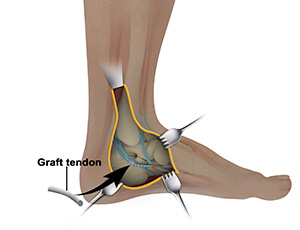What is Posterior Tibialis Tendon Repair?
 Posterior tibialis tendon repair is a surgery performed to repair an injured or torn posterior tibialis tendon. The tear may occur as a result of a fall or break/dislocation of the ankle. The surgery may also be performed for chronic inflammation of the posterior tibialis tendon due to overuse.
Posterior tibialis tendon repair is a surgery performed to repair an injured or torn posterior tibialis tendon. The tear may occur as a result of a fall or break/dislocation of the ankle. The surgery may also be performed for chronic inflammation of the posterior tibialis tendon due to overuse.
The posterior tibialis tendon is a cord of strong fibrous tissue. It passes through the ankle to attach the calf muscle with the bones of the mid foot. It provides stability to the arch and supports the foot while walking. Inflammation or a tear of this tendon as a result of injury may cause dysfunction, leading to pain and the development of flatfoot. Posterior tibialis tendon repair can help relieve painful symptoms and restore normal foot and ankle function.
Indications for Posterior Tibialis Tendon Repair
Posterior tibialis tendon repair is recommended for treatment of the following conditions:
- Posterior tibialis tendon dysfunction
- Flatfoot, also known as “fallen arches” or Pes planus
- Posterior tibialis tendon injury or rupture
- Your symptoms have lasted for more than 6 months
- You have significant loss of function and weakness in the foot
- You are an athlete and wish to return to sports soon
- Non-surgical treatments have failed to alleviate symptoms
Preparation for Posterior Tibialis Tendon Repair
In general, preoperative preparation for posterior tibialis tendon repair will involve the following steps:
- A thorough examination is performed by your doctor to check for any medical issues that need to be addressed prior to surgery.
- Depending on your medical history, social history, and age, you may need to undergo tests such as bloodwork and imaging to screen for any abnormalities that could threaten the safety of the procedure.
- You will be asked if you have allergies to medications, anesthesia, or latex.
- You should inform your doctor of any medications, vitamins, or supplements that you are taking.
- You should refrain from supplements or medications such as blood thinners, aspirin, or anti-inflammatory medicines for 1 to 2 weeks prior to surgery.
- You should refrain from alcohol or tobacco at least a week before surgery.
- You should not consume solids or liquids at least 8 hours prior to surgery.
- Arrange for someone to drive you home after surgery.
- A written consent will be obtained from you after the surgical procedure has been explained in detail.
Procedure for Posterior Tibialis Tendon Repair
Posterior tibialis tendon repair may be performed as an open surgery, where a large incision is made, or a minimally invasive arthroscopic surgery, where small incisions are made to insert an arthroscope (a thin tube with a camera and light source) and miniature surgical tools.
In general, the procedure involves the following steps:
- You will lie on your back on the operating table under general or spinal anesthesia.
- A long surgical cut is made through the skin and muscle of your lower calf.
- The underlying muscles are carefully separated to expose the damaged posterior tibialis tendon.
- Your surgeon then makes an incision through the sheath that surrounds the tendon and repairs or removes sections of the damaged tendon.
- In some instances, where the tendon has been severely damaged, your surgeon may take out another tendon from your foot and use it to replace all or a section of the severely damaged tendon.
- After accomplishing adequate repair of the tendon, the overlying soft tissue and skin around your calf are closed with sutures and sterile bandages are applied.
Postoperative Care and Recovery
In general, postoperative care instructions and recovery after posterior tibialis tendon repair will involve the following steps:
- You will be transferred to the recovery area where your nurse will closely observe you for any allergic/anesthetic reactions and monitor your vital signs as you recover.
- Your ankle will be immobilized in a splint for a specified period of time to protect the ankle and facilitate healing.
- You may notice some pain and discomfort in the operated area. Pain and anti-inflammatory medications are provided as needed.
- Antibiotics are also prescribed to address the risk of surgery-related infection.
- Keep the foot elevated at or above the level of your heart to help minimize swelling and discomfort.
- Do not weight-bear on the operated leg. A walking boot or a non-weight-bearing cast is recommended for a few weeks to support the foot.
- Assistive devices such as crutches and walkers are recommended to maintain balance and stability while walking for several weeks.
- Start rehabilitation (physical therapy) as recommended by your surgeon to improve range of motion. You should begin appropriate exercises to stretch and strengthen the foot and ankle muscles.
- Keep the surgical site clean and dry. Instructions on surgical site care and bathing will be provided.
- You can resume most of your normal activities in 4 months’ time. However, refrain from strenuous activities and lifting heavy weights for at least 6 months or longer. Gradual increase in activities over a period of time is recommended.
- Return to sports is recommended only when the foot has regained its normal strength and function and with your doctor’s approval.
- A periodic follow-up appointment will be scheduled to monitor your progress.
Risks and Complications
Posterior tibialis tendon repair is a relatively safe procedure; however, as with any surgery, some risks and complications may occur, such as the following:
- Infection
- Bleeding
- Damage to nerves and vessels
- Thromboembolism or blood clots
- Anesthetic/allergic reactions
- Calf muscle weakness
- Persistent foot and ankle pain


